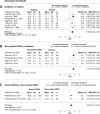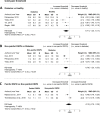Altered pain processing in patients with type 1 and 2 diabetes: systematic review and meta-analysis of pain detection thresholds and pain modulation mechanisms
- PMID: 32868312
- PMCID: PMC7462232
- DOI: 10.1136/bmjdrc-2020-001566
Altered pain processing in patients with type 1 and 2 diabetes: systematic review and meta-analysis of pain detection thresholds and pain modulation mechanisms
Abstract
The first signs of diabetic neuropathy typically result from small-diameter nerve fiber dysfunction. This review synthesized the evidence for small-diameter nerve fiber neuropathy measured via quantitative sensory testing (QST) in patients with diabetes with and without painful and non-painful neuropathies. Electronic databases were searched to identify studies in patients with diabetes with at least one QST measure reflecting small-diameter nerve fiber function (thermal or electrical pain detection threshold, contact heat-evoked potentials, temporal summation or conditioned pain modulation). Four groups were compared: patients with diabetes (1) without neuropathy, (2) with non-painful diabetic neuropathy, (3) with painful diabetic neuropathy and (4) healthy individuals. Recommended methods were used for article identification, selection, risk of bias assessment, data extraction and analysis. For the meta-analyses, data were pooled using random-effect models. Twenty-seven studies with 2422 participants met selection criteria; 18 studies were included in the meta-analysis. Patients with diabetes without symptoms of neuropathy already showed loss of nerve function for heat (standardized mean difference (SMD): 0.52, p<0.001), cold (SMD: -0.71, p=0.01) and electrical pain thresholds (SMD: 1.26, p=0.01). Patients with non-painful neuropathy had greater loss of function in heat pain threshold (SMD: 0.75, p=0.01) and electrical stimuli (SMD: 0.55, p=0.03) compared with patients with diabetes without neuropathy. Patients with painful diabetic neuropathy exhibited a greater loss of function in heat pain threshold (SMD: 0.55, p=0.005) compared with patients with non-painful diabetic neuropathy. Small-diameter nerve fiber function deteriorates progressively in patients with diabetes. Because the dysfunction is already present before symptoms occur, early detection is possible, which may assist in prevention and effective management of diabetic neuropathy.
Keywords: chronic pain; diabetes complications; diabetic neuropathies.
© Author(s) (or their employer(s)) 2020. Re-use permitted under CC BY-NC. No commercial re-use. See rights and permissions. Published by BMJ.
Conflict of interest statement
Competing interests: None declared.
Figures




Similar articles
-
Altered pain processing in people with type I and II diabetes: a protocol for a systematic review and meta-analysis of pain threshold and pain modulation mechanisms.Syst Rev. 2018 Dec 5;7(1):222. doi: 10.1186/s13643-018-0895-2. Syst Rev. 2018. PMID: 30518431 Free PMC article.
-
Continuum of sensory profiles in diabetes mellitus patients with and without neuropathy and pain.Eur J Pain. 2022 Nov;26(10):2198-2212. doi: 10.1002/ejp.2034. Epub 2022 Sep 15. Eur J Pain. 2022. PMID: 36069121 Free PMC article.
-
The level of small nerve fiber dysfunction does not predict pain in diabetic Neuropathy: a study using quantitative sensory testing.Clin J Pain. 2006 Mar-Apr;22(3):261-5. doi: 10.1097/01.ajp.0000169670.47653.fb. Clin J Pain. 2006. PMID: 16514326 Clinical Trial.
-
Acetyl-L-carnitine for the treatment of diabetic peripheral neuropathy.Cochrane Database Syst Rev. 2019 Jun 15;6(6):CD011265. doi: 10.1002/14651858.CD011265.pub2. Cochrane Database Syst Rev. 2019. PMID: 31201734 Free PMC article.
-
Novel and Emerging Electrophysiological Biomarkers of Diabetic Neuropathy and Painful Diabetic Neuropathy.Clin Ther. 2021 Sep;43(9):1441-1456. doi: 10.1016/j.clinthera.2021.03.020. Epub 2021 Apr 24. Clin Ther. 2021. PMID: 33906790 Review.
Cited by
-
Ultramicronized N-Palmitoylethanolamine Regulates Mast Cell-Astrocyte Crosstalk: A New Potential Mechanism Underlying the Inhibition of Morphine Tolerance.Biomolecules. 2023 Jan 25;13(2):233. doi: 10.3390/biom13020233. Biomolecules. 2023. PMID: 36830602 Free PMC article.
-
Changes of intestinal microbiome and its relationship with painful diabetic neuropathy in rats.BMC Microbiol. 2025 May 8;25(1):281. doi: 10.1186/s12866-025-04015-2. BMC Microbiol. 2025. PMID: 40335921 Free PMC article.
-
Prevalence, distribution and correlates of pain in patients with mucormycosis-A cross-sectional study.Saudi J Anaesth. 2022 Jan-Mar;16(1):52-57. doi: 10.4103/sja.sja_680_21. Epub 2022 Jan 4. Saudi J Anaesth. 2022. PMID: 35261589 Free PMC article.
-
Peripheral Neuropathy in Diabetes Mellitus: Pathogenetic Mechanisms and Diagnostic Options.Int J Mol Sci. 2023 Feb 10;24(4):3554. doi: 10.3390/ijms24043554. Int J Mol Sci. 2023. PMID: 36834971 Free PMC article. Review.
-
Detecting Peripheral Neuropathy in Patients with Diabetes, Prediabetes and other High-Risk Conditions: An Advanced Practice Nurse's Perspective.J Med Clin Nurs. 2022;3(2):143. doi: 10.47363/jmcn/2022(3)143. Epub 2022 Mar 21. J Med Clin Nurs. 2022. PMID: 35445219 Free PMC article.
References
-
- World Health Organization Global report on diabetes. Geneva; 2016.
Publication types
MeSH terms
LinkOut - more resources
Full Text Sources
Medical
Miscellaneous
